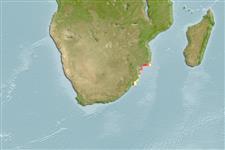Elasmobranquios (tiburones y rayas) (sharks and rays) >
Rajiformes (Skates and rays) >
Anacanthobatidae (Smooth skates)
Etymology: Anacanthobatis: Greek, ana = up + Greek, akantha = thorn + Greek, batis, -idos = a ray (Ref. 45335).
Environment: milieu / climate zone / depth range / distribution range
Ecología
marino batidemersal; rango de profundidad 230 - 322 m (Ref. 5578). Deep-water; 24°S - 30°S, 29°E - 40°E (Ref. 57365)
Western Indian Ocean: known only from southern Mozambique to Durban, South Africa.
Tamaño / Peso / Age
Maturity: Lm ? range ? - ? cm
Max length : 29.0 cm TL macho / no sexado; (Ref. 95335)
Short description
Claves de identificación | Morfología | Morfometría
Espinas dorsales (total) : 0. A brown-spotted legskate with smooth skin and a short slender tail less than body length; snout angular with tiny filament; pectoral disc with rounded corners; no large thorns on denticles except for alar spines on adult males (Ref. 5578). Legskates have pelvic fins separated into a mobile leg-like front lobe, and a rear lobe that may be fused to the tail base (Ref. 5578). Mottled brown and white with scattered ocelli dorsally; uniform pale ventrally (Ref. 6510). Papillae and rostral filament dark brown (Ref. 6510).
Possibly the smallest southern African skate (Ref. 5578). Found on the upper slope (Ref. 5578).
Life cycle and mating behavior
Madurez | Reproducción | Puesta | Huevos | Fecundidad | Larva
Distinct pairing with embrace (Ref. 205).
McEachran, J.D. and K.A. Dunn, 1998. Phylogenetic analysis of skates, a morphologically conservative clade of elasmobranchs (Chondrichthyes: Rajidae). Copeia 1998(2):271-290. (Ref. 27314)
IUCN Red List Status (Ref. 130435: Version 2024-1)
Threat to humans
Harmless
Human uses
Pesquerías:
Herramientas
Special reports
Download XML
Fuentes de Internet
Estimates based on models
Phylogenetic diversity index (Ref.
82804): PD
50 = 0.6250 [Uniqueness, from 0.5 = low to 2.0 = high].
Bayesian length-weight: a=0.01000 (0.00244 - 0.04107), b=3.04 (2.81 - 3.27), in cm total length, based on all LWR estimates for this body shape (Ref.
93245).
Nivel trófico (Ref.
69278): 3.6 ±0.6 se; based on size and trophs of closest relatives
Resiliencia (Ref.
120179): Bajo, población duplicada en un tiempo mínimo de 4.5-14 años (Assuming fecundity<100).
Fishing Vulnerability (Ref.
59153): Low vulnerability (19 of 100).
